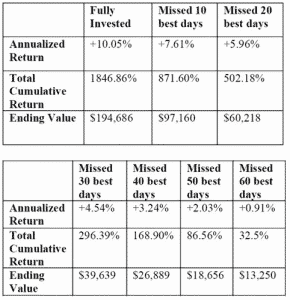How to Survive the next Market Downturn

Everything you need to know about surviving the next market downturn: we are in the longest bull market in US history. After more than a decade of record-high stock returns, many investors are wondering if there is another market downturn on the horizon. With so many people saving for retirement in 401k plans and various retirement accounts, it’s normal if you are nervous. But if you are a long-term investor, you know these market downturns are inevitable. Market downturns are stressful but a regular feature of the economic cycle.
What is the market downturn?
A market downturn is also known as a bear market or a market correction. During a market downturn, the stock market will experience a sharp decline in value. Often, market downturns are caused by fears of recession, political uncertainty, or bad macroeconomic data.
How low can the market go down?
The largest-ever percentage drop by the S&P 500 index occurred on October 19, 1987 (known as The Black Monday), when the S&P 500 dropped by -20.47%. The next biggest selloff happened on October 15, 2008, when the S&P 500 lost –9.03%. In both cases, the stock market continued to be volatile for several months before reaching a bottom. Every time, the end of the market downturn was the start of a new bull market. Both times, the stock market recovered and reached historic highs in a few years.
What can you do when the next market downturn happens?
The first instinct you may have when the market drops is to sell your investments. In reality, this may not always be the right move. Selling your stocks during market selloff may limit your losses, may lock in your gains but also may lead to missed long-term opportunities. Emotional decisions do not bring a rational outcome.
Dealing with declining stock values and market volatility can be tough. The truth is nobody likes to lose money. The volatile markets can be treacherous for seasoned and inexperienced investors alike. To be a successful investor, you must remain focused on the strength of your portfolio, your goals, and the potential for future growth. I want to share nine strategies that can help you through the next market downturn and boost the long-term growth of your portfolio.
1. Keep calm during the market downturn
Stock investors are cheerful when the stock prices are rising but get anxious during market corrections. Significant drops in stock value can trigger panic. However, fear-based selling to limit losses is the wrong move. Here’s why. Frequently the market selloffs are followed by broad market rallies. A V-shape recovery often follows a market correction.
The hypothetical table below looks at the performance of $10,000 invested in the S&P 500 between January 4, 1988, and December 31, 2018. It’s important to note this hypothetical investment occurred during two of the biggest bear markets in history, the 2000 tech bubble crash and the 2008 global financial crisis. If you had missed the ten best market days, you would lose 2.4% of your average annual return and nearly half of your dollar return.

As long as you are making sound investment choices, your patience and the ability to tolerate paper losses will earn you more in the long run.
2. Be realistic: Don’t try to time the market
Many investors believe that they can time the market to buy low and sell high. In reality, very few investors succeed in these efforts.
According to a study by the CFA Institute Financial Analyst Journal, a buy-and-hold large-cap strategy would have outperformed, on average, about 80.7% of annual active timing strategies when the choice was between large-cap stocks, short-term T-bills, and Treasury bonds.
3. Stay diversified
Diversification is essential for your portfolio preservation and growth. Diversification, or spreading your investments among different asset classes (domestic versus foreign stocks, large-cap versus small-cap equity, treasury and corporate bonds, real estate, commodities, precious metals, etc.), will lower the risk of your portfolio in the long-run. Many experts believe that diversification is the only free lunch you can get in investing.
Uncorrelated asset classes react uniquely during market downturns and changing economic cycles.
For example, fixed income securities and gold tend to rise during bear markets when stocks fall. Conversely, equities rise during economic expansion.
4. Rebalance your portfolio regularly
Rebalancing your portfolio is a technique that allows your investment portfolio to stay aligned with your long terms goals while maintaining a desired level of risk. Typically, portfolio managers will sell out an asset class that has overperformed over the years and is now overweight. With the proceeds of the sale, they will buy an underweighted asset class.
Hypothetically, if you started investing in 2010 with a portfolio consisting of 60% Equities and 40% Fixed Income securities, without rebalancing by the end of 2019, you will hold 79% equities and 21% fixed income. Due to the last decade’s substantial rise in the stock market, many conservative and moderate investors are now holding significant equity positions in their portfolio. Rebalancing before a market downturn will help you bring your investments to your original target risk levels. If you reduce the size of your equity holdings, you will lower your exposure to stock market volatility.
5. Focus on your long-term goals
A market downturn can be tense for all investors. Regardless of how volatile the next stock market correction is, remember that “this too shall pass.”
Market crises come and go, but your goals will most likely remain the same. In fact, most goals have nothing to do with the market. Your investment portfolio is just one of the ways to achieve your goals.
Your personal financial goals can stretch over several years and decades. For investors in their 20s and 30s financial goals can go beyond 30 – 40 years. Even retirees in their 60s must ensure that their money and investments last through several decades.
Remain focused on your long-term goals. Pay of your debt. Stick to a budget. Maintain a high credit score. Live within your means and don’t risk more than you can afford to lose.
6. Use tax-loss harvesting during the market downturn
If you invest in taxable accounts, you can take advantage of tax-loss harvesting opportunities. You can sell securities at depressed prices to offset other capital gains made in the same year. Also, you can carry up to $3,000 of capital losses to offset other income from salary and dividends. The remaining unused amount of capital loss can also be carried over for future years for up to the allowed annual limit.
To take advantage of this option, you have to follow the wash sale rule. You cannot purchase the same security in the next 30 days. To stay invested in the market, you can substitute the depressed stock with another stock that has a similar profile or buy an ETF.
7. Roth Conversion
A falling stock market creates an excellent opportunity to do Roth Conversion. Roth conversion is the process of transferring Tax-Deferred Retirement Funds from a Traditional IRA or 401k plan to a tax-exempt Roth IRA. The Roth conversion requires paying upfront taxes with a goal to lower your future tax burden. The depressed stock prices during a market downturn will allow you to transfer your investments while paying lower taxes. For more about the benefits of Roth IRA, you can read here.
8. Keep a cash buffer
I always recommend to my clients and blog readers to keep at least six months of essential living expenses in a checking or a savings account. We call it an emergency fund. It’s a rainy day, which you need to keep aside for emergencies and unexpected life events. Sometimes market downturns are accompanied by recessions and layoffs. If you lose your job, you will have enough reserves to cover your essential expenses. You will avoid dipping in your retirement savings.
9. Be opportunistic and invest
Market downturns create opportunities for buying stocks at discounted prices. One of the most famous quotes by Warren Buffet is “When it’s raining gold, reach for a bucket, not a thimble.” Market selloffs rarely reflect the real long-term value of a company as they are triggered by panic, negative news, or geopolitical events. For long-term investors, market downturns present an excellent opportunity to buy their favorite stocks at a low price. If you want to get in the market after a selloff, look for established companies with strong secular revenue growth, experienced management, solid balance sheet and proven track record of paying dividends or returning money to shareholders.
Final words
Market downturns can put a huge toll on your investments and retirement savings. The lack of reliable information and the instant spread of negative news can influence your judgment and force you to make rash decisions. Market selloffs can challenge even the most experienced investors. That said, don’t allow yourself to panic even if it seems like the world is falling apart. Prepare for the next market downturn by following my list of nine recommendations. This checklist will help you “survive” the next bear market while you still follow your long-term financial goals.
Contact Us

